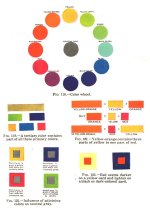gordo
Well-known member
Organizing colors into some kind of system may have started some 16,000 years ago with the earliest artists, the Cro-Magnons, who lived in the cave that came to be known as Lascaux in France - as this wall painting and close up seems to suggest.


However, the oldest color system known today originates from the Finnish born astronomer, priest and Neoplatonist Aron Sigfrid Forsius, sometimes also known as Siegfried Aronsen. In 1629, a manuscript appeared in which Forsius expounded his thoughts about colors, concluding that they could be organized into a spacial order.
Forsius states: "Amongst the colors there are two primary colors, white and black, in which all others have their origin." Forsius is here in agreement with Leonardo da Vinci who, more than three hundred years earlier, had included black and white amongst the colors, seeing them next to yellow, red, blue and green as primaries. Forsius then continues: "In the middle, between these colors (black and white), red has been placed on the one side since the classical antiquity, and blue on the other; yellow then comes between white and red, pale yellow between white and yellow, orange between yellow and red ..." and so forth, until Forsius has completed the whole circle. Forsius uses four basic colors (red, yellow, green and blue) which he observes, together with grey as a "median color", between the two extremes of black and white. Forsius had the idea of introducing four basic chromatic colors, applying for each color a gray scale which runs from bright to dark along the central axis of a sphere. The colors on the sphere's surface are arranged in such a way that three opposing pairs are created: red and blue, yellow and green, white and black. Forsius had thus paved the way for modern color systems.
Phillipp Otto Runge 1810

From "Handbook of Lithography" 1919

From "Show Card Writing" 1922

From "The Art of Colour" 1924

From "Commercial Art" 1930

From "The Age of Color" 1936

From "Color" 1943


From "Practical Printing and Binding"1946

However, the oldest color system known today originates from the Finnish born astronomer, priest and Neoplatonist Aron Sigfrid Forsius, sometimes also known as Siegfried Aronsen. In 1629, a manuscript appeared in which Forsius expounded his thoughts about colors, concluding that they could be organized into a spacial order.
Forsius states: "Amongst the colors there are two primary colors, white and black, in which all others have their origin." Forsius is here in agreement with Leonardo da Vinci who, more than three hundred years earlier, had included black and white amongst the colors, seeing them next to yellow, red, blue and green as primaries. Forsius then continues: "In the middle, between these colors (black and white), red has been placed on the one side since the classical antiquity, and blue on the other; yellow then comes between white and red, pale yellow between white and yellow, orange between yellow and red ..." and so forth, until Forsius has completed the whole circle. Forsius uses four basic colors (red, yellow, green and blue) which he observes, together with grey as a "median color", between the two extremes of black and white. Forsius had the idea of introducing four basic chromatic colors, applying for each color a gray scale which runs from bright to dark along the central axis of a sphere. The colors on the sphere's surface are arranged in such a way that three opposing pairs are created: red and blue, yellow and green, white and black. Forsius had thus paved the way for modern color systems.
Phillipp Otto Runge 1810
From "Handbook of Lithography" 1919
From "Show Card Writing" 1922
From "The Art of Colour" 1924
From "Commercial Art" 1930
From "The Age of Color" 1936
From "Color" 1943
From "Practical Printing and Binding"1946













